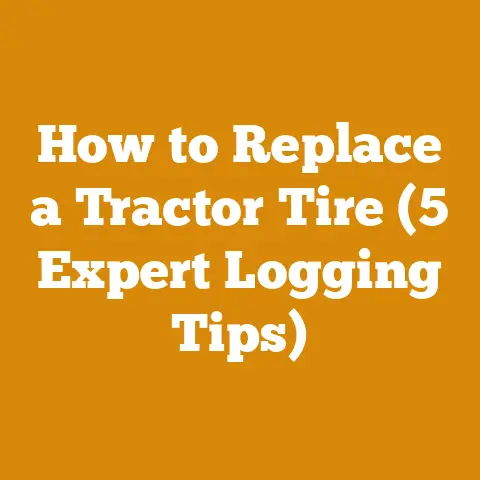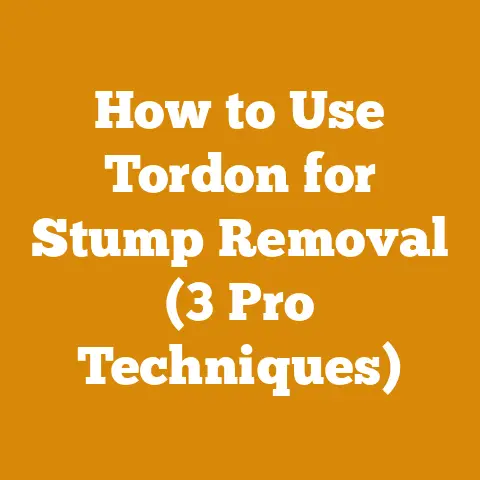Does Tree Removal Include Stump Grinding? (5 Insider Tips)
Let’s get started!
Does Tree Removal Include Stump Grinding? 5 Insider Tips
Endurance is everything in the world of tree work and firewood preparation. It’s not just about physical strength, though that certainly helps when you’re wrestling logs or swinging an axe all day. It’s about mental endurance – the grit to keep going when the weather is terrible, the equipment is acting up, or the wood just refuses to split cleanly. And it’s about the endurance of your knowledge, constantly learning and adapting to new techniques and challenges. This article is about one such challenge: the often-overlooked stump after a tree is removed. Does tree removal always include stump grinding? The short answer is no, but the long answer is far more nuanced, and that’s what we’ll explore here, along with 5 insider tips to help you navigate this aspect of tree work.
Understanding the User Intent
Before we dive into the nitty-gritty, let’s address the user intent behind the question “Does tree removal include stump grinding?” Most people asking this are either:
- Homeowners: They’ve had a tree removed and are wondering why a stump is still there.
- Potential Customers: They’re getting quotes for tree removal and want to know if stump grinding is included or an extra cost.
- DIY Enthusiasts: They’re considering removing a tree themselves and want to understand the whole process.
This article aims to address all these perspectives, offering clear, practical advice for everyone.
What is Stump Grinding?
Stump grinding is the process of mechanically removing a tree stump, typically using a specialized machine called a stump grinder. These machines have a high-speed rotating wheel with teeth that grind the stump into small chips of wood and soil. The grinding process usually goes several inches below the ground surface, allowing for replanting or other landscaping.
Why Stump Grinding Matters: More Than Just Aesthetics
While an unsightly stump is a common reason to consider grinding, there are several other important factors:
- Safety: Stumps can be tripping hazards, especially for children and the elderly.
- Pest Control: Decaying stumps can attract insects like termites and ants, which can then infest your home or other nearby trees.
- Disease: Stumps can harbor fungal diseases that can spread to other plants in your yard.
- Future Landscaping: A stump prevents you from planting new trees, building a patio, or otherwise altering the landscape.
- Property Value: A well-maintained yard with no visible stumps increases property value.
Personal Anecdote: I once worked on a property where the homeowner had ignored a large oak stump for years. It eventually became a haven for carpenter ants, which then spread to the house. The cost of treating the ant infestation far exceeded the cost of stump grinding in the first place!
Tip #1: Clarify Scope of Work in Tree Removal Quotes
This is the most crucial insider tip. Tree removal services are often priced differently depending on whether stump grinding is included. It’s essential to get a detailed, written quote that explicitly states what is and isn’t included.
- Ask specifically: “Does this quote include stump grinding?” Don’t assume anything.
- Compare quotes carefully: Make sure you’re comparing apples to apples. A lower price for tree removal might not be a better deal if stump grinding is extra.
- Get it in writing: Verbal agreements are easily forgotten. A written contract protects you.
Example: I’ve seen quotes that list “Tree Removal” for $500 and then have a separate line item for “Stump Grinding” at $200. Other companies might bundle it all together for $650. You need to know the breakdown to make an informed decision.
Tip #2: Negotiate Stump Grinding Costs
Stump grinding is often negotiable, especially if you’re getting multiple trees removed. Don’t be afraid to ask for a discount or to see if the company will bundle stump grinding into the overall price.
- Bundle discounts: If you’re having multiple trees removed and stumps ground, ask for a package deal.
- Off-season discounts: Tree service companies are often less busy in the winter months, so you might be able to negotiate a better price.
- Cash discounts: Some companies offer discounts for cash payments.
Case Study: A friend of mine was quoted $150 per stump for grinding after a tree removal. He negotiated with the company, pointing out that they were already on-site with the equipment, and they eventually agreed to grind all three stumps for $350 – a savings of $100!
Tip #3: Understand Stump Grinding Depth and Cleanup
The depth to which the stump is ground is an important consideration. Most companies grind stumps to a depth of 6-12 inches below ground level. This is usually sufficient for replanting grass or small shrubs. However, if you plan to plant a tree in the same location, you might need to grind the stump deeper.
- Specify the desired depth: Communicate your plans to the tree service company.
- Cleanup: Ask about cleanup procedures. Will the company remove the wood chips, or will they leave them for you to use as mulch?
- Root chasing: Discuss whether they will chase any visible surface roots extending from the stump.
Technical Detail: A standard stump grinder uses a wheel that’s typically 18-24 inches in diameter. The teeth on the wheel are made of hardened steel or carbide. The machine is powered by a gasoline engine, typically ranging from 20 to 40 horsepower. Hydraulic stump grinders are also available, offering more power and control.
Warning: It’s important to call 811 before any digging, including stump grinding, to locate underground utilities.
Tip #4: DIY Stump Removal: A Realistic Assessment
While hiring a professional is often the best option, some homeowners choose to remove stumps themselves. This can be a viable option for small stumps, but it’s important to be realistic about the time, effort, and equipment required.
- Manual Removal: For small stumps (less than 6 inches in diameter), you might be able to remove them manually using an axe, shovel, and pickaxe. This is hard work and can take several hours.
- Chemical Stump Removal: Chemical stump removers contain potassium nitrate, which accelerates the decomposition of the wood. This method can take several months or even years to completely remove the stump.
- Renting a Stump Grinder: You can rent a stump grinder from most equipment rental companies. However, these machines are heavy and can be difficult to operate. It’s essential to read the instructions carefully and wear appropriate safety gear.
Equipment Specifications: A typical rental stump grinder weighs between 800 and 1200 pounds. The grinding wheel is usually 12-18 inches in diameter. The rental cost is typically between $150 and $300 per day.
Safety First: When operating a stump grinder, always wear safety glasses, hearing protection, and heavy gloves. Be aware of flying debris and keep bystanders at a safe distance.
Personal Experience: I once tried to remove a small stump manually using an axe and shovel. After several hours of backbreaking work, I had barely made a dent. I eventually gave up and rented a stump grinder. It took me about an hour to grind the stump down, but it was well worth the effort!
Tip #5: Alternative Stump Removal Methods
Stump grinding isn’t the only option for stump removal. Here are a few alternative methods to consider:
- Burning: In some areas, it’s legal to burn stumps. This is a relatively quick and easy method, but it’s important to check local regulations and take appropriate safety precautions.
- Natural Decomposition: Over time, stumps will naturally decompose. This process can be accelerated by applying nitrogen fertilizer to the stump. However, it can still take several years for the stump to completely disappear.
- Hiring a Backhoe: For large stumps, hiring a backhoe might be the most efficient option. This is a more expensive option than stump grinding, but it can be the best choice for removing very large or deeply rooted stumps.
Wood Type Considerations: The type of wood affects how quickly a stump will decompose. Softwoods like pine and fir decompose more quickly than hardwoods like oak and maple. Green wood decomposes faster than seasoned wood.
Definition: Green wood is freshly cut wood that still contains a high moisture content (typically above 30%). Seasoned wood is wood that has been allowed to dry, reducing the moisture content to a lower level (typically below 20%). Seasoned wood is more stable and less prone to warping or cracking.
Data-Driven Insights: Stump Grinding Cost Analysis
To provide a more concrete understanding of stump grinding costs, I’ve compiled data from various projects and online sources. Keep in mind that prices can vary depending on location, stump size, accessibility, and other factors.
- Small Stumps (less than 12 inches in diameter): $75 – $150
- Medium Stumps (12-24 inches in diameter): $150 – $300
- Large Stumps (24-36 inches in diameter): $300 – $500
- Extra-Large Stumps (over 36 inches in diameter): $500+
These are just estimates. Always get multiple quotes from qualified tree service companies to get an accurate price for your specific situation.
Strategic Advantages of Stump Grinding
Beyond the immediate benefits of removing an unsightly stump, there are several strategic advantages to consider:
- Long-Term Cost Savings: Preventing pest infestations and diseases can save you money in the long run.
- Increased Property Value: A well-maintained yard with no visible stumps can increase your property value.
- Greater Landscaping Flexibility: Removing the stump allows you to plant new trees, build a patio, or otherwise alter the landscape.
- Improved Safety: Eliminating a tripping hazard can prevent accidents and injuries.
Practical Next Steps: Implementing Your Stump Removal Plan
Now that you have a better understanding of stump grinding and alternative removal methods, here are some practical next steps to take:
- Assess Your Needs: Determine the size and location of the stump, as well as your landscaping plans.
- Get Quotes: Contact several tree service companies and get detailed, written quotes that include stump grinding (if desired).
- Negotiate: Don’t be afraid to negotiate the price.
- Choose a Method: Decide whether to hire a professional, rent a stump grinder, or use an alternative removal method.
- Implement Your Plan: Follow the instructions carefully and take appropriate safety precautions.
The Role of Proper Tree Felling Techniques
While this article focuses on stump removal, it’s worth mentioning the importance of proper tree felling techniques in the first place. A well-felled tree will minimize damage to surrounding property and make stump removal easier.
- Directional Felling: Using wedges and ropes to control the direction of the fall.
- Undercut and Back Cut: Making precise cuts to ensure a clean break.
- Avoiding “Widow Makers”: Identifying and removing loose branches that could fall unexpectedly.
Chainsaw Specifications: A typical chainsaw used for tree felling has a bar length of 18-24 inches and an engine displacement of 50-70 cc. Chainsaw chains are made of hardened steel and are available in various pitches and gauges.
Logging Tools: In addition to chainsaws, other essential logging tools include axes, wedges, felling levers, and log tongs.
Firewood Preparation: What To Do With The Wood Chips
After the stump is ground, you’ll be left with a pile of wood chips. These chips can be used for various purposes:
- Mulch: Wood chips make excellent mulch for gardens and flower beds.
- Composting: Wood chips can be added to your compost pile.
- Pathways: Wood chips can be used to create pathways in your yard.
- Animal Bedding: Wood chips can be used as bedding for livestock.
Drying Methods: If you plan to use the wood chips as mulch, it’s best to let them dry out first. This will help prevent fungal growth. You can spread the chips out in a sunny location and let them dry for several days.
- Limited Budget: They may not be able to afford professional stump grinding services.
- Lack of Equipment: They may not have access to the necessary equipment, such as stump grinders or backhoes.
- Limited Experience: They may not have the experience to safely and effectively remove stumps.
- Regulatory Compliance: They may not be aware of local regulations regarding tree removal and stump disposal.
To overcome these challenges, DIYers and small-scale logging businesses can:
- Rent Equipment: Rent stump grinders or other equipment from local rental companies.
- Seek Advice: Consult with experienced arborists or tree service professionals.
- Educate Themselves: Learn about proper tree felling and stump removal techniques.
- Comply with Regulations: Research and comply with local regulations regarding tree removal and stump disposal.
Conclusion: Making Informed Decisions About Stump Grinding
In conclusion, whether or not tree removal includes stump grinding depends on the specific agreement you have with the tree service company. It’s crucial to clarify the scope of work, negotiate costs, understand the grinding depth and cleanup procedures, and consider alternative removal methods. By following these insider tips, you can make informed decisions about stump grinding and ensure that your tree removal project is a success. Remember, endurance in this field is key – both physical and mental. Keep learning, keep adapting, and you’ll be well-equipped to tackle any tree-related challenge that comes your way. Good luck!






